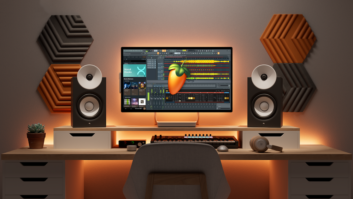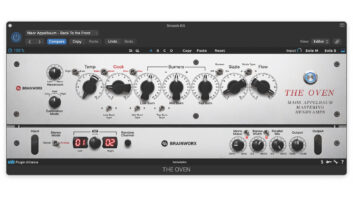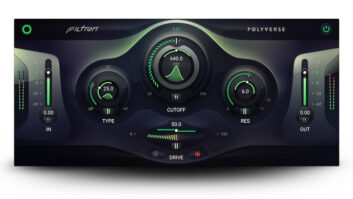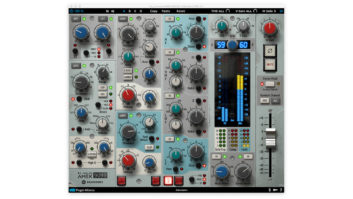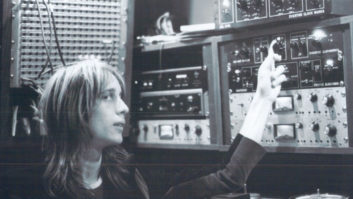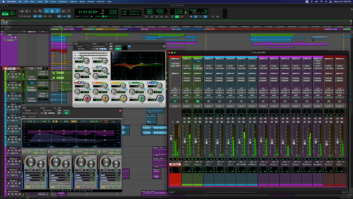by Christopher Walsh.

Most engineers feel that modeling of analog hardware has progressed to a point at which they can confidently work with software-based emulations. At the same time, new processing plug-ins allow manipulation of audio that was previously not possible.
Regardless of whether they use everything within a particular plug-in bundle, many professionals consider a bundle a wise investment. Some plug-ins are ‘go-to’ on virtually every session, while others unexpectedly bestow the perfect vibe in a particular situation.
In a recent announcement, Mark of the Unicorn announced that the MasterWorks Collection for Digital Performer is now available for the Pro Tools, Logic Pro, Live and Cubase platforms. The MasterWorks Collection consists of EQ, Leveler and ProVerb.
For Digital Performer and Logic user George Landress, who has been mixing for artists (and Digital Performer users) Snuffy Walden and Keb’ Mo’, this is good news. “I am presently using it with Digital Performer,” he says, “and just ordered native, so I’m looking forward to using it in Logic as well.”
Mixing for television scores, says Landress, “I have to work quickly. One of the aspects of how you work and mix quickly is relying on plug-ins that you know are going to operate efficiently.”
The MasterWorks Collection’s user-friendly GUIs, he adds, enable fast and efficient work. “We’re working with these plug-ins graphically, and sometimes it’s hard, or cumbersome, to grab the line and pull down your center to wherever you’re going,” he explains. “The way MasterWorks is laid out, the two bottom bands are set up so that even though you can select between shelf and parametric, my eye goes to these two bands. I use a lot of low and high shelf simultaneously, where I want to filter off some bottom end on acoustic guitar and bring some shimmer up. I can’t tell you how easy it is to use the MasterWorks EQ: press two buttons to turn it on, grab the two little boxes on the line and it’s done.
“I found myself using the Leveler more and more,” he adds. “When I got DP files from Snuffy, I noticed that he had inserted [Leveler] into one of his guitar channels. I was listening and saying ‘What is this? This sounds great!’ Then I started fiddling between the Modern and Vintage buttons, and found a plethora of color. It’s a combination of variation of color and that vintage look.”
With the exception of the SSL 4000 Collection, the Waves Audio Mercur bundle features “the world of Waves in one massive collection,” says the manufacturer.
“Everybody gets their arsenal in their mind over the years: ‘When I want to do this, I go to this plug-in,'” observes Mercury bundle owner Andrew Scheps. “For me, a lot of those are Waves plug-ins because I’m used to them. The cool thing is that when new things come up, very often I start trolling through the Waves stuff, because there’s so much of it–and so much that I don’t necessarily know inside out–that there’s probably something cool in there. For me, that’s one of the best things about the Mercury bundle: just how massive it is.
“I still use some of the old bare-bones plug-ins because I’m used to them and they’re very simple,” Scheps adds. “But some of the newer stuff they’ve been modeling is amazing, and they’re modeling things other people aren’t. They did a Helios input channel and a Pye compressor. They sound great, but they also sound unlike anything else I’ve got, which is a huge plus. I still use a lot of analog equipment too, so it has to be pretty special to bother EQ’ing in the box when I’ve got a bunch of Neve EQs here. The Helios EQ sounds like no other EQ I’ve ever used, and in a really good way.”
“There almost isn’t anything in [the Mercury bundle] that you won’t use somewhere along the way,” says Ross Hogarth. “They have the whole scope, and are definitely the go-to limiters for a lot of cats. Look across the board: you’ve got classic, known sounds; ‘let’s solve problems’ plug-ins; strict ‘I’m gonna EQ this’ plug-ins; and recently, they came up with H-Comp and H-Delay, which is a great delay.”
The Waves Update Plan allows plug-in owners to download the latest versions or additions to their purchases (WUP fees are capped at $200 for such extensive bundles as Mercury).
The SoundToys TDM Effects bundle draws high praise from many professionals. For the History Channel’s Pawn Stars, Rich Tozzoli made extensive use of EchoBoy, among other plug-ins in the bundle. Pawn Stars, says Tozzoli, “is a ‘vintage guitar’-sounding show. Every single cue–and it’s wall-to-wall music–is guitars: old, bluesy, desert-y. EchoBoy is the best guitar and vocal echo in the business. I use it on every single session, it’s in my presets.”
“You hear [EchoBoy] on 90 percent of the records that are out,” says Christian Baker, an engineer at Germano Studios in New York. “It’s an industry standard at this point.”
“I’ve had that bundle for quite awhile,” adds Ryan Hewitt, “and it’s really my go-to effects. The versatility of EchoBoy is phenomenal, so I don’t need to go anywhere else. The Tremolator is great to create guitar and vocal effects, and the Decapitator is one of my favorite distortion plug-ins. I’ve gotten a lot of use out of that.”
For Animal Planet program The Haunted, Tozzoli employs SoundToys’ Crystallizer. “You never know what you’re going to get,” he says. “I call up a synth patch, and if I want to create something different, I go to the Crystallizer and simply run through the presets–they have so many good presets. It’s stuff you could never come up with on your own; it’s the magical combination of their presets.”
For Gary Tole, freelance engineering sessions at Sony Music Studios in New York gave him experience with the Sony OXF-R3 “Oxford” console. “I loved the sound of it,” he recalls. “I loved the EQs and the dynamics, so when they became available [as plug-ins], I jumped on them.”
The Sonnox Elite bundle is comprised of Oxford EQ, Dynamics, Inflator, Transient Modulator, Reverb, Limiter and SuprEsser. “I like the EQs in particular because they can be musical and clinical at the same time,” says Tole. “You can use them in a very tonal sense where you do a wide brushstroke-type of thing, or you can get right in and totally rip things apart when you want to.
“The Limiter is great because I can hit it fairly hard without it sounding like anything is happening with it, or I can really hit it with the Enhance slider and make it sound warmer, like you’re hitting tape,” he adds. “It’s very varied in the sonic landscape that it provides.
“Fortunately or unfortunately, with people wanting everything louder, I use the Inflator a lot, because I can get things almost ‘record-ready,’ mastering-wise, without it sounding like it’s squashing the dynamics all down,” Tole continues. “I end up using the Inflator quite a bit on final mixes. Not as a mix bus necessarily, but as a mastering step, because I do a lot of pre-mastering. There have also been instances where the [client] likes what the Inflator had done more than the chain the mastering engineer used, and we’ve gone back to the Inflator.”
It wasn’t familiarity with the Oxford console that grabbed DJ/producer/remixer Jay-J, but “when I grab the EQ it’s really easy and quick. Of course, there wasn’t anything like the Transient Modulator. I’ve used it mostly to bring out the attacks a little more. In those cases, it’s usually for, let’s say, percussion, a background piece that I want to be audibly steady–compressed–so that the volume stays consistent and it’s a nice piece in the background, retaining the subtle dynamics from the hits but still maintaining that overall level. I can dial in a little bit of TransMod to get some of that back but do it in a controlled way. It’s not like having to use a compressor with a slow attack; I still have hits that are all over the place audibly, but I can really rein it in and sculpt the sound to be a steady background thing that’s not distracting.
“The other thing I’ve done with it is to soften the attack on, say, a hi-hat or a snare, or even a guitar that’s being picked really hard. I can use that in place of a compressor to soften those attacks. So there’s a couple of ways that I’ve utilized it.”
For “avid” Pro Tools user Glenn Rosenstein–no pun intended, he insists–Avid‘s Complete Production Toolkit bundle combines power and portability. The expansion option for Pro Tools LE allows up to 128 tracks and 7.1 surround mixing, and includes a range of plug-ins and virtual instruments.
“The biggest ‘up’ with the Complete Production Toolkit is the ability to port off of my HD rig far larger-channel sessions and far higher track counts, and still be able to edit on my laptop,” Rosenstein explains. “That, for me, is the biggest advantage, and being able to use that along with my Mbox Mini is really awesome. I’m traveling and editing a record with headphones. All of the plug-ins that CPT comes with are good and it’s a great bonus.”
The evolution of the Pro Tools platform, he adds, now offers “closer and closer access to virtually everything you might have in an HD rig. I’m running an HD Accel with an expansion chassis, so the LE with the CPT is my secondary rig. But it could work for anybody as a primary rig. Many of the plug-ins that I’m already using in my HD system have compatible plug-ins through the LE with CPT on it. It has become so transparent that I don’t think about which ones are on one rig and which are on my smaller rig. Of course, [CPT] comes with Eleven, Hybrid, Smack! Structure, DINR for noise reduction, X-Form time compression, Neyrinck surround-to-stereo downmixer, the MP3 Option–that’s something I use all the time. There are just fundamental system changes that CPT does that empower you do a lot more with your LE than you would be able to otherwise.”
The URS Classic Console Strip Pro and Strip bundle, says Hogarth, “is a very powerful tool. [URS co-founder] Bobby Nathan has gone way over the top in modeling: tape machines, every single front end, every compression algorithm and EQ algorithm from Motown to Neve to API. He’s modeled all that, even saturation. So you have unbelievable control over every parameter, and how to actually use your signal flow.”
“The URS Everything EQ bundle is pretty cool for a lot of vintage sounding stuff,” Baker adds. “There are a couple of mix engineers that use that all the time. Old-school guys want to use it–it looks like the old gear, and it sounds like they would expect old gear in a rack to sound like.”
There are numerous uses, says Hewitt, for the TG 12413 Limiter, a component of the Abbey Road Plug-in Bundle. “I use it on drum room, acoustic guitars–it’s fantastic–and piano,” Hewitt reveals. “Also electric guitar and vocals. There are times when you want a very transparent compressor and times you want something very aggressive, and this is a very aggressive sound and very ‘analog,’ very flavorful. It’s not transparent at all. For that sort of application, it’s one of the best out there.”
Hewitt also owns a Chandler Limited TG1, the hardware reissue of the TG12413. “For drum room, I think the hardware piece is better,” he confides, “but for guitars, it’s the opposite: I prefer the software. I can’t give you a reason other than that’s what I’ve come to find is useful.
“I don’t believe that any plug-in is exact,” Hewitt concludes. “Most often, it’s close to the character of the hardware piece that we’re used to. In this case, it’s extremely close: the distortion characteristics are really similar, and the way the limiter grabs the signal is spot-on.”
Artist Vail Johnson uses the Focusrite Forte Suite as an RTAS plug-in in Pro Tools LE and is impressed with its ISA 110 EQ plug-in. “I’m astonished at the responsiveness of the EQ sections,” he says. “Just like a real ‘old-school’ hardware device, 1 or 2 dB of boost or cut really makes a difference, as opposed to many plug-ins I use that seem to need 5-6 dB to hear anything happening. Remember that too much boost will be way too much.
The ISA 130 compressor, he adds, “is also very responsive, and you can use a simple ‘couple dB compression/couple dB make-up gain’ approach, or go at it with complete control of every parameter available to the Forte console owner.”
“I hate to say this, because I’m old-school,” Landress summarizes, “but we really rely on plug-ins. In a best-case scenario, give me analog. But in the real, practical world of application, at some point we have to work in the box. Plug-ins like this really make it a pleasure.”
